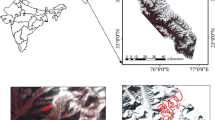Abstract
Snow avalanche studies require different snow-meteorological parameters for avalanche forecasting. Snow surface temperature is one of the major parameters, which is responsible for the evolution of snow pack characteristics. In the present paper, the snow surface temperature was estimated using TERRA satellite based — Moderate resolution imaging spectroradiometer (MODIS) sensor for NW-Himalayas. Ground data observed by automatic weather stations (AWS) was used to calibrate the brightness temperature obtained by MODIS thermal bands data into the actual snow surface temperature data through regression analysis. A split window technique has been implemented for the estimation of snow surface temperature. The multi-date satellite derived snow surface temperature was validated with ground data of winter 2004–05 and 2005–06 collected at various observation stations located in different ranges of NW-Himalaya. Good correlations were observed for Upper Himalaya (0.98, 0.98), Middle Himalaya (0.92, 0.96) and Lower Himalaya (0.88, 0.82) for 2004–05 and 2005–06 winter respectively. Further, estimated snow surface temperature was also verified with snow-cover information collected by manned observatories and area delineated by thematic maps of snow surface temperature was validated with the different snow climatic zones of NW-Himalaya.
Similar content being viewed by others
References
Brown. O.B. and Minnett P.J. (1996). MODIS Infrared Sea Surface Temperature Algorithm. Algorithm Theoretical Basis Document, Version1.0. October (1996).
Dale, Peter (2005). Introduction to mathematical Techniques used in GIS, Boca Raton; CRC Press, pp. 173–194.
Haefliger, M., Steffen, K. and Fowler, C. (1993). AVHRR surface temperature and narrow-band albedo comparison with ground measurements for the Greenland ice sheet.Annals of Glaciology,17: 49–54.
Hall. D.K. and Riggs, G A. (2001). Algorithm Theoretical Basis Document (ATBD) for the MODIS Snow and Sea Ice-Mapping Algorithms, MODIS LST ATBD. Version3.3, September 2001.
Hall, D.K., Key, J.R., Casey, K.A., Riggs. G.A. and Cavalieri, D.J. (2004). Sea Ice Surface Temperature Product from MODIS.IEEE Transactions on Geoscience and Remote Sensing,42(5): 1078–1087
Joseph, G. (2000). Fundamentals of Remote Sensing. 1st Edition, University Press, Hydrabad, pp. 384.
Key, J., Collins, J., Fowler, C. and R. Stone (1997). High- latitude surface temperature estimates from thermal satellite data.Remote Sensing Environment,61: 302–309.
Lindsay, R. and Rothrock, D. (1993). The calculation of surface temperature and albedo of Arctic sea ice from AVHRR.Annals of Glaciology,17: 391–397.
Oerlemans, J. (2000). ‘Analysis of a 3 year meteorological record from the ablation zone of Morteratschgletschgletscher, Switzerland: energy and mass balance’.Journal of Glaciology,46(155): 571–579.
Prasanjit, D., Frank-M, G., Folke-S, O. and Herbert, F. (2001). Retrival of Land Surface Temperature and Emissivity from Satellite Data: Physics, Theoretical Limitations and Current Methods.Journal of Indian Society of Remote Sensing,29(1&2): 23–30.
Qin, Z. and Karnieli, A. (1999). Progress in the remote sensing of land surface temperature and ground emissivity using NOAA-AVHRR data.Int. Journal of Remote Sensing,20(12): 2367–2393.
SASE Annual Technical Reports (2005, 2006). Snow and Avalanche Study Establishment, Manali, India.
Sharma, S.S. and Ganju, A. (2000). Complexities of avalanche forecasting in Western Himalaya — an overview.Cold Regions Science and Technology,31: 95–102.
Singh. A.K. (1994). A Mathematical model for the study of temperature profile with a snowcover. Proceedings of Snowsymposium, 26-27 Sep 1994. pp. 147–156.
Ulaby, F.T., Moore, R.K. and Fung. A.K. (1990). ‘Microwave Remote Sensing Fundamentals and Radiometry’, Vol.1. Book-Mart Press, Inc. North Bergen. N J.
Upadhyay, D.S. (1995). Cold Climate Hydro-meteorology, New Age international (P) Ltd., pp. 160.
Wan, Z. and Dozier, J. (1996). A Generalized Split- Window Algorithm for Retrieving Land — Surface Temperature from Space.IEEE Transactions on Geoscience and Remote Sensing,34(4): 892–905.
Wan, Z. (1999). MODIS Land-Surface Temperature Algorithm Theoretical Basis Document (LST ATBD), Version3.3, April 1999.
Author information
Authors and Affiliations
Corresponding author
About this article
Cite this article
Negi, H.S., Thakur, N.K. & Mishra, V.D. Estimation and validation of snow surface temperature using modis data for snow-avalanche studies in NW-Himalaya. J Indian Soc Remote Sens 35, 287–299 (2007). https://doi.org/10.1007/BF02990785
Received:
Revised:
Issue Date:
DOI: https://doi.org/10.1007/BF02990785




